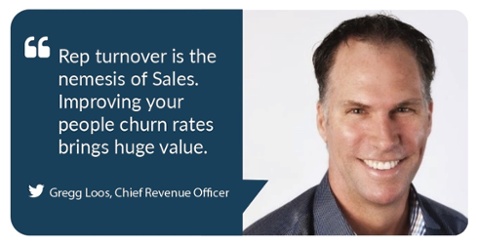Losing more than 3 of every 10 people on your staff each year frankly seems ridiculous. However, in Sales that’s often reality. Taking both voluntary and involuntary departures into account, Sales rep turnover is reported as high as a staggering 34% annually¹.

The turnover landscape
The costs associated with losing and then replacing sales reps are significant. Straightforward expenditures such as recruiting, training and ramping reps to baseline knowledge level are measurable alone. Start adding on more nuanced items like the opportunity costs of interrupted lead follow-up, stalled progress in target accounts, and traction lost in pipeline building and you can quickly see the huge problem of unmet quotas added to direct expenses incurred. If you’re always playing catch up on hiring and training, scaling is difficult and impacts both your Sales team and company’s financial success.
 We spoke to Gregg Loos, Chief Revenue Officer at First San Francisco Partners and career Sales Executive, for his perspective on tackling turnover.
We spoke to Gregg Loos, Chief Revenue Officer at First San Francisco Partners and career Sales Executive, for his perspective on tackling turnover.
“Rep turnover is the nemesis of Sales,” Gregg shared, “Understanding where your voluntary and involuntary attrition stems from and improving your people churn rates brings huge value to the organization.”
5 factors of sales rep churn and how to address them
Evaluating the causes of rep turnover requires your organization to be willing to take an introspective look at your organizational culture and your management approach.
- Build a buyer-centric culture. You don’t need free beer and on-demand access to ping-pong to impress your reps, you need to support them. Is your company truly supportive of Sales? There are the rare reps out there that are so creative, smart and hungry that they’ll refuse to let a lack of tools, resources or knowledge get in their way. But let’s be reasonable—you can’t expect this from every rep if you want to scale. Consider how your entire organization supports your customers and buyers, then look at what your do for your sales team. In a buyer-centric organization, sales reps are given the research, tools and resources to understand and support their buyers in their buying cycles. We’ve outlined what makes a buyer-centric company here.
- Develop career paths and attainable incentives. Basing your sales reps’ incentive model on something that a skilled, intelligent and hardworking rep isn’t likely to achieve sets you both up for failure. Incentive plans should be achievable to motivate reps who put in the focus, diligence and creativity that B2B Selling demands of them. At any given time, your reps should know if they are on track for reaching quota, achieving performance expectations and understand the path to their next career step.
- Evaluate your training model. It’s hard to deliver customized training, but your reps aren’t all the same. They don’t all learn the same way, or come from the same background. It’s efficient to standardize the experience, but if you give everyone the same training and resources without the right feedback loop, it’s difficult to judge where an individual needs more help. Make sure to consider a resource set that supports different learning styles across your materials and coaching.
- Take a serious look at your playbooks. Do your playbooks help your reps easily understand their target accounts and the actions they can take to help move their deals forward? Are they easy to access and use? If not, you’re missing a huge opportunity to manage performance and set your reps up to close more deals. Help your reps see for themselves what actions will help them close deals and make sure you acknowledge their successes to reinforce your coaching.
- Have a data-driven understanding of performance issues. One of the biggest issues sales managers face is unwittingly mismanaging reps through a lack of pipeline visibility and quality information about rep activity and performance. When you make decisions about who to let go, it should be based on data and facts about how the reps work, perform and sell. Without that data, it comes down to conjecture, hearsay, personal bias or fuzzy information about deals that may never have been real opportunities. Instead, when you look at how a rep is pursuing a deal using a data driven approach, you can identify skill gaps or performance issues for specific selling touch points and pinpoint areas to train, coach or motivate that individual. You can also do a better job of setting expectations in an explicit manner. “Just giving your reps a model of the pipeline review, or a map of what won deals look like, that provides unbelievable valuable.”
If you can spot any of these five areas in your organization and tackle even one of them, you’ll be on your way to improving that frightening turnover statistic. Not sure where to get started? Akoonu for Sales helps Sales Reps and Managers take deals from opportunity to close with a new level of visibility into buyer behavior so you can know what actions matter in account-based selling.




